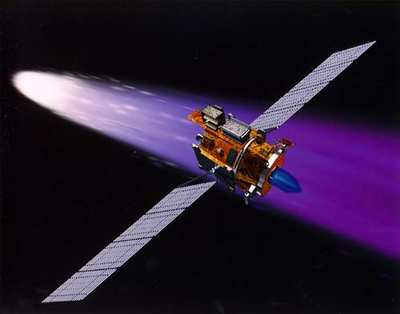New Propulsion Method For Deep Space?
 It's
the kind of long-term, trouble-free engine performance that every
vehicle operator would like to see, achieved by an ion engine
running for a record 30,352 hours at NASA's Jet Propulsion
Laboratory in Pasadena (CA).
It's
the kind of long-term, trouble-free engine performance that every
vehicle operator would like to see, achieved by an ion engine
running for a record 30,352 hours at NASA's Jet Propulsion
Laboratory in Pasadena (CA).
The engine is a spare of the Deep Space 1 ion engine used during
a successful technology demonstration mission that featured a bonus
visit to comet Borrelly. It had a design life of 8,000 hours, but
researchers kept it running for almost 5 years -- from Oct. 5,
1998, to June 26, 2003 -- in a rare opportunity to fully observe
its performance and wear at different power levels throughout the
test. This information is vital to future missions that will use
ion propulsion, as well as to current research efforts to develop
improved ion thrusters.
"Finding new means to explore our solar system -- rapidly,
safely and with the highest possible return on investment -- is a
key NASA mission," said Colleen Hartman, head of Solar System
Exploration at NASA Headquarters, Washington (DC). "Robust in-space
flight technologies such as ion propulsion are critical to this
effort and will pioneer a new generation of discovery among our
neighboring worlds."

While the engine had not yet reached the end of its life, the
decision was made to terminate the test because near-term NASA
missions using ion propulsion needed analysis data that required
inspection of the different engine components. In particular, the
inspection of the thruster's discharge chamber, where xenon gas is
ionized, is critical for mission designers of the upcoming Dawn
mission. Dawn, part of NASA's Discovery Program, will be launched
in 2006 to orbit Vesta and Ceres, two of the largest asteroids in
the solar system.
 "The chamber was in good condition,"
said John Brophy, JPL's project element manager for the Dawn ion
propulsion system. "Most of the components showed wear, but nothing
that would have caused near-term failure."
"The chamber was in good condition,"
said John Brophy, JPL's project element manager for the Dawn ion
propulsion system. "Most of the components showed wear, but nothing
that would have caused near-term failure."
Marc Rayman, former Deep Space 1 project manager,
said, "There are many exciting missions into the solar system that
would be unaffordable or truly impossible without ion propulsion.
This remarkable test shows that the thrusters have the staying
power for long duration missions."
Ion engines use xenon, the same gas used in photo flash tubes,
plasma televisions and some automobile headlights. Deep Space
1 featured the first use of an ion engine as the primary method of
propulsion on a NASA spacecraft. That engine was operated for
16,265 hours, the record for operating any propulsion system in
space. Ion propulsion systems can be very lightweight, because they
can run on just a few grams of xenon gas a day. While the thrust
exerted by the engine is quite gentle, its fuel efficiency can
reduce trip times and lower launch vehicle costs. This makes it an
attractive propulsion system choice for future deep space
missions.
"The engine remained under vacuum for the entire test, setting a
new record in ion engine endurance testing, a true testament to the
tremendous effort and skill of the entire team," said Anita
Sengupta, staff engineer in JPL's Advanced Propulsion Technology
Group. "This unique scientific opportunity benefits current and
potential programs."
"The dedicated work of NASA's Solar Electric Technology
Application Readiness test team, led by JPL, continues to exemplify
a commitment to engineering excellence," said Les Johnson, who
leads the In-Space Propulsion Program at NASA's Marshall Space
Flight Center, Huntsville, Ala. "This work, along with significant
contributions from NASA's Glenn Research Center in Cleveland, will
take NASA's space exploration to the next level."
 ANN's Daily Aero-Term (04.26.24): DETRESFA (Distress Phrase)
ANN's Daily Aero-Term (04.26.24): DETRESFA (Distress Phrase) Aero-News: Quote of the Day (04.26.24)
Aero-News: Quote of the Day (04.26.24) ANN's Daily Aero-Term (04.27.24): Direct
ANN's Daily Aero-Term (04.27.24): Direct ANN's Daily Aero-Linx (04.27.24)
ANN's Daily Aero-Linx (04.27.24) Aero-News: Quote of the Day (04.27.24)
Aero-News: Quote of the Day (04.27.24)





